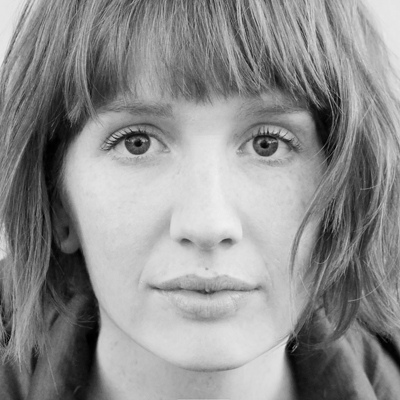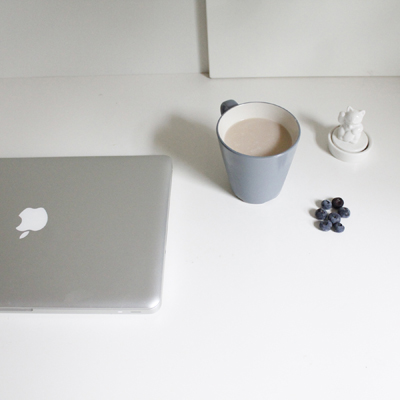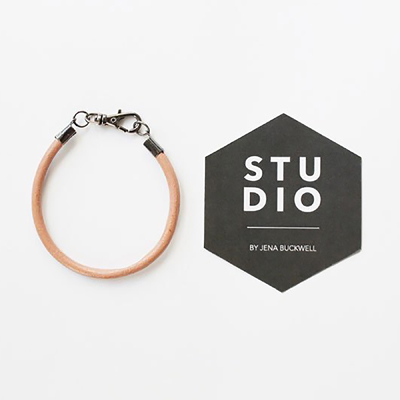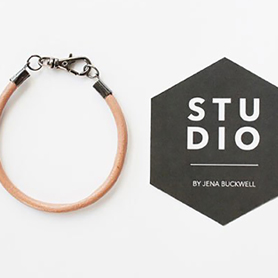Jena Buckwell
Owner and Designer at Jena Buckwell

Primary design concentration:
Publishing and Editorial Design
Most preferred tools for designing:
I have a Moleskine where a lot of my personal projects begin just as notes or as illustrations and wireframes. Otherwise, I spend most of my time in InDesign.

My very simple workspace
How and why did you choose to become a designer?
Before I was old enough to really have a concept of what has to happen to make a magazine, I decided that I wanted to work in the art department of a fashion magazine when I grew up. For a young girl living in a town of 5,000, magazines were a bit of a creative escape for me. I always felt unreasonably excited when Interview, Vogue, and Bitch would show up in the mailbox, or on the stand at the bookstore in town, and I wanted to be a part of it. I realize in hindsight that what excited me was the possibility of creating something elegant, tangible, and approachable.
After graduating from college, I moved to New York City with two suitcases and no job prospects. I moved into a friend’s closet, slept on a blow-up mattress and was offered a job at Glamour four days later. I spent a little less than a year working as a freelancer at Glamour, New York Magazine, and InStyle, before taking a full-time position at Women’s Wear Daily. During that time, while my love of designing and art-directing for fashion remained, I grew pretty exhausted with the culture of the fashion industry and simply came to the realization that I didn’t belong there (or in New York City, for that matter). So, I transitioned to more general publication work, as well as marketing and branding design, and ultimately moved out of New York City to pursue my own design business, while simultaneously pursuing my passion for local foods and sustainable farming in a nice, quiet city in the Shenandoah Valley.

Moodboard for a personal project focused on hiking in the Shenandoah Valley, Virginia
What are some of the challenges you encounter as a designer and how do you deal with them?
The biggest challenge I’ve faced, thus far, was my decision to leave the city. I had this horrible feeling that my career would just wash up and all the hard work I put into building up my résumé and my reputation would be for absolutely nothing. There’s still a chance that could all happen, but in the end, I decided that while a having a career is important, my life and my happiness are so much more than my job title, and living in New York City was never going to be fulfilling to me. Otherwise, I’d say my biggest challenge is saying No. I really just started my solo business, and while having work and clients is important, it’s more important to me to have the right ones. I am working toward running a business that is my own and that reflects my creative vision, and if I take every job that’s thrown at me, chances are good that I’ll be doing a lot of work that reflects the client’s vision much more so than my own.
What is your definition of an "elegant solution," that is, good design?
I tend to be highly focused on usability. While it is obviously important for something to be beautiful, it’s equally or more important that something serves an actual purpose and fulfills that purpose in an understandable, legible way. I am also pretty nitpicky about details, especially typesetting details and consistency. For me, a design being “tight” is absolutely essential.

Branding created for a side business of handmade jewelry
From skills to values, what makes a designer successful?
It’s important to be the person that knows what they’re talking about (though, at the very beginning of your career, you probably don’t know what you’re talking about and you should just listen and learn), but that is still open to others’ opinions and needs. A willingness to be flexible—without throwing your ideals out the window—makes for someone that is respected by their clients. I’ve learned that if someone is interested in working with me, but doesn’t respect me as the authority in design, it’s not really worth working with this kind of client. Be professional, thoughtful, and considerate at all times, even if a client is driving you crazy, and you need to be firm with them—there is always a way to get your point across without losing your cool (and it’s better to do so sooner rather than later).
How do you stay motivated and grow personally and professionally as a designer?
I am a major personal-project junkie. I usually have one or two projects going on, at any time, that are just for my own personal enjoyment. I also highly recommend Skillshare to any creative. It’s a great community, and there are plenty of classes that will help guide a personal project in a very fulfilling way. Be open to talking to new people. I am personally not a fan of networking-type events, so I tend to just keep an eye out for opportunities in my daily life that could lead to some new interesting connection or work. Knowing people who know people is really important.
For those aspiring to become a designer, whatever the discipline, what is your advice?
In the beginning, spend a lot of time being quiet and listening to what more experienced designers have to say (even if you don’t agree). Being a creative professional can be extremely trying at times, and you’ll never have the satisfaction of having an exactly right answer to anything, so get used to it. Be open to change, be open to new ideas, and always be nice. It’s okay if your job is not your life. I feel like it’s extremely prevalent for creative professionals to be constantly immersed in their work, encouraging the blurred lines between their career and themselves and identifying their entire existence by what they make and who they work for. You’re more than your résumé, and developing and maintaining genuine relationships are more important than your job title. Remember to call home from time to time.
What is your quest in design, from a professional practice, education or evolution standpoint?
I aspire to create value-adding tools that are also beautifully designed. I am very focused on localism and love working on projects, whether for a client or personal, that truly benefit my community. A huge benefit to leaving New York City is that I can improve my current city. I’m no longer just another designer, I am a important member of a growing community.
Previous: Ivy Kim | Next: Annaka Olsen

Support this solo initiative
What began as a collection of links has evolved into a comprehensive archive committed to creative culture—offering so far 395 interviews with under-the-radar Artists, Designers & Makers, in addition to 202 write-ups across events, books, movies, more. Free to explore. Free from ads. If you gain a level of motivation, knowledge, even delight, from Design Feast, please support on Patreon. Thanks for your consideration!
Wishing you continual success,
Nate Burgos, Content Creator & Publisher
Comments
There are no comments yet.
Leave Your Comment